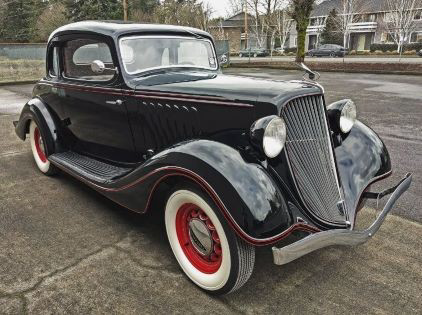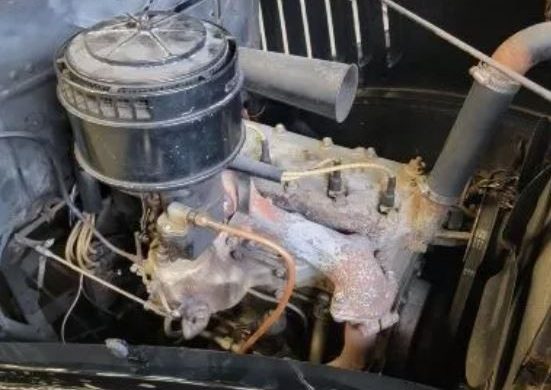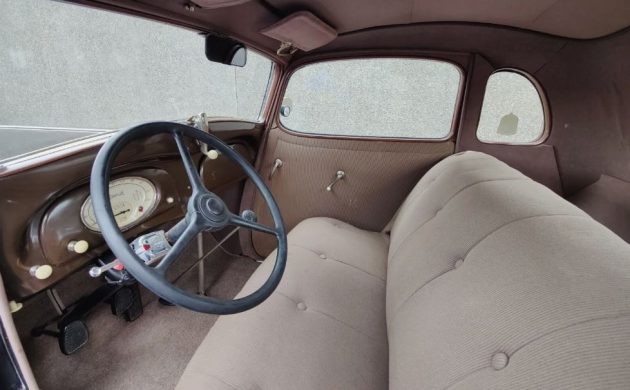Businesses were gutsy during the Great Depression. Somehow, they had to survive, and mostly, that meant taking risks. Packard entered the middle market, GM emphasized the low end of the market, and Chrysler cost-cut until Plymouth represented most of its profit. At Hudson, Roy Chapin followed in the footsteps of GM, introducing the Terraplane, a lightweight but powerful car at a low price point. With its good looks, peppy engine, innovative gearbox, and safety-minded brakes, Terraplanes soon outsold the Hudson brand itself. It didn’t hurt that Hudson employed “influencers” Amelia Earhart and Orville Wright to speak for the car; each of them signed up for early deliveries. This 1934 Terraplane business coupe has been for sale for several months; perhaps the seller better understands the market for his car, so it can find a new home this time around.
To understand the Terraplane, one minute’s contemplation of the Essex is required. The Essex was Hudson’s low-end offering in the early 1920s. The company upgraded the Essex motor from a four-cylinder to a six by 1924, achieving larger displacement and better power output long before Henry Ford even thought about it. Still, the six wasn’t as reliable as the four, and the Essex lost market share. Chapin asked that the six be re-engineered and bored out, and both power and reliability improved. Further innovation arrived when the short-wheelbase Terraplane platform received the new motor. Rumor has it that gangsters like John Dillinger preferred the Terraplane for getaways (and we’re not talking about the weekend type) because acceleration beat most other cars and top speed hovered around 70-80 mph. The six-cylinder engine displaces 212 cu. in. and makes about 85 hp; the odometer reads 60,300 miles, said to be original. This example has a manual transmission, instead of Hudson’s optional electric gear shift. The electrical system is still six-volt, and the underside can barely be criticized. The seller reports that it runs and drives well.
The interior is slightly moth-eaten, but the gauge set is bright and clean, staining is minimal, and the glass is good. The seller reports that the fender welt is quite worn, mild blistering is showing up on the exterior paint, and some of the chrome plating is thin. While I appreciate the honesty, this car presents pretty well for its age, and given the unusual make, I’m even more willing to forgive its foibles.
This Terraplane is listed here on eBay, and bidding has reached $15,820. A buy-it-now is set at $28,500. This car is located in Portland, Oregon, which is feeling like Terraplane Central since our best comparable showed up with an Oregon title as well: this blue 1934 coupe sold for $20,500 a few years ago. Meanwhile, you’ll recall that we mentioned that today’s example has been for sale for a few months: this article covers its auction in February on eBay, where it was bid to at least $25,600 with a buy-it-now in the $32k area. What’s the right price on this aging beauty?






These are always a nice departure from the mainstream. I sure wouldn’t kick a car like this off my driveway. It might not keep up with a Ford V8 but it wouldn’t be as tempramental either. There’s a guy over west who has one similar to this one. I see him bring it out to the occasional show’n’shine. It’s always a big hit. I do remember another guy coming to an antique car convention with the sedan version of this. He only came that one time but he drove over 1500 miles to attend the party…
There is just something trippy about this one. Hard to explain. But it starts with the name.
Why. are the rear leaf springs wrapped and laced? Anyone?
The rear springs here are not wrapped in anything but dust, though the transverse springs on some early Fords were wrapped. This car has some dirty areas but looks like a nice #3 car, and very nice streamline styling.
Whoops. Sorry about the vaugeness.
The car at the link “this blue 1934” coupe has wraps.
Great grill
“Rumor has it that gangsters like John Dillinger preferred the Terraplane for getaways (and we’re not talking about the weekend type)…”
That’s a great play on words and pretty funny besides, Michelle😆.
A remarkable car in so many ways and unique. The way it blends everything together is amazing and a perfect example of the time this beauty was made.
It’s almost a lost art anymore to contour lines like these with a handheld scribe and paper, but it’s going that way so enjoy it while we can.
I remember hearing about the Terraplane as a little kid from my Grandpa. He was a dyed in the wool Chevy guy from the 1930s until he bought his last one in 89. He had told me that back in the day these were quite the performance car during that time. He had a friend who owned one in the 30s, they were racing each other to a lake in Up State NY where he lived. His friend and his girlfriend passed my Grandpa who was driving his Chevy. Tragically he had an accident that day, his friend didnt make it, but the girlfriend survived. I wont go into all the details, it wasnt pretty, and now as Im typing this Im kind of wondering why he got into such great detail with an 8 year old. But anyway, I guess thats why the Terraplane name sticks with me, I always thought that it was a great name for a car.
“And when I mash down on your little starter, then your sparkplug will give me fire.” ~Robert Johnson, “Terraplane Blues”
Great reference for a dyed in the wool Bluesman!
A rare car that needs to be preserved as does the history and progenitors of the Blues like Robert Johnson :)
Agree 1000%, Mountainwoodie. There was no one like Robert Johnson.
I do love this car also.
Kudos for the reference, Czech Dude!
Robert Johnson, a rather famous blues musician, wrote a song about the Terraplane that includes the words “cool one hundred” referring to the speed.
On older cars we would oil in between each spring and then wrap them to keep the dirt out and the oil in between each spring.
Leaf springs should never be lubricated. The friction between the leaves provides the dampening effect. Lubrication makes the springs too spongy.
Got it. Thanks.
My dad who was born in 1921 told me that his first car was a Terraplane. I can’t remember the year of the car. He also told me he rolled it without getting into details. I always thought Terraplane was a great name for a car. I’ve only seen a few of them in my travels to car shows in the considerable number of years I’ve been in the hobby. This a very nice vehicle and has some very stylish features. GLWTS.
What was the “electric gear shift” vs the regular manual? Anyone?
The most beautiful grill ever. One year only.
That was Hudson’s “Electric Hand”—an early attempt at a semi automatic transmission. They are very rare today as most ended up in the trash can. Of those that still exist, very few actually work.
This is a beautiful car. If a talented upholsterer could patch the moth eaten parts while retaining the rest the original upholstery It would be a great looking and driving car.
cars in more than 1 song.
Late sixties also, no?
My Grandpa was a Hudson man from
way back and wasn’t able to buy one,
So when the Terraplane came out in
’33, he bought one– a 4-door sedan
that was very dependable and soundly built. Being a tool and die man for a major Midwestern company, allowed him to buy a new
Terraplane every year til they stopped
making them in ’38 or ’39 or thereabouts. He would drive his last
one through WWII and beyond until
he would buy one of the new stepdown models in ’48. His last stepdown was a ’52 Hornet 4-door
sedan with a 308.big 6 with twin
H-power and the 12-X cylinder head.
This is the car that I can recall him driving in my earliest memories. It was long, low, and very very wide with
big cushy seats that would swallow a
small boy whole! The Hornet would be his last Hudson though. When he
found out that Hudson was closing up shop in ’57, he bought a ’58 Ford
Country sedan that he wasn’t ever happy with. He became a loyal GM
owner in 1960 where he stayed til his
passing in 1973. Thanks for the
memories
The electric gear shifter was a selector mounted on the steering post where the turn signal lever is today. Using the same pattern as the floor shift, but a small toggle that was put in the proper place for each gear. Let the clutch out and the car moved, while in first and accelerating move toggle second position, depress clutch and trans shifted to second, etc.
Some also had vacuum clutch operation when gas pedal was let up.
Hudson used a cork clutch plate. Steel plate with holes drilled in it and cork pressed in the holes. It ran in a special oil and was super smooth.
Other manufacturers used the same shift system. I don’t remember who manufactured it, but it wasn’t made by Hudson.